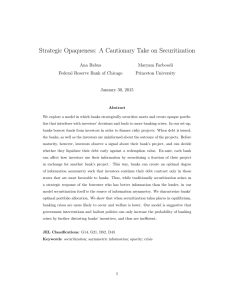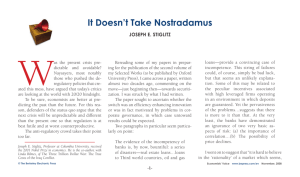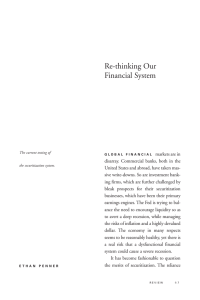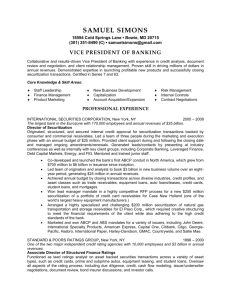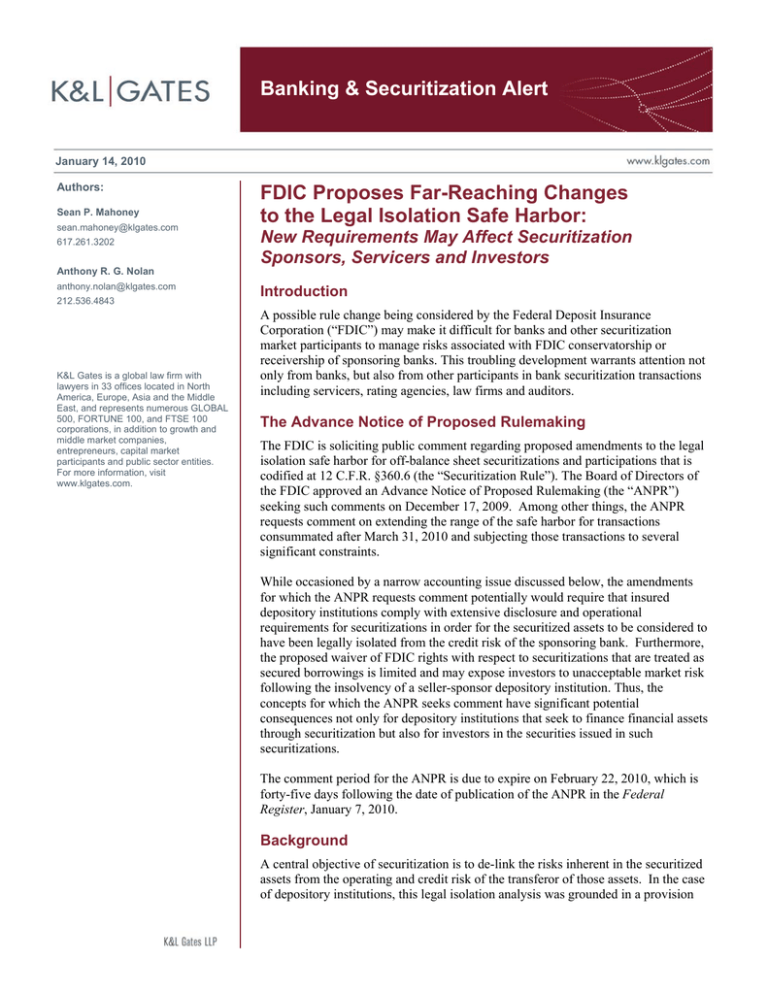
Banking & Securitization Alert
January 14, 2010
Authors:
Sean P. Mahoney
sean.mahoney@klgates.com
617.261.3202
FDIC Proposes Far-Reaching Changes
to the Legal Isolation Safe Harbor:
New Requirements May Affect Securitization
Sponsors, Servicers and Investors
Anthony R. G. Nolan
anthony.nolan@klgates.com
212.536.4843
K&L Gates is a global law firm with
lawyers in 33 offices located in North
America, Europe, Asia and the Middle
East, and represents numerous GLOBAL
500, FORTUNE 100, and FTSE 100
corporations, in addition to growth and
middle market companies,
entrepreneurs, capital market
participants and public sector entities.
For more information, visit
www.klgates.com.
Introduction
A possible rule change being considered by the Federal Deposit Insurance
Corporation (“FDIC”) may make it difficult for banks and other securitization
market participants to manage risks associated with FDIC conservatorship or
receivership of sponsoring banks. This troubling development warrants attention not
only from banks, but also from other participants in bank securitization transactions
including servicers, rating agencies, law firms and auditors.
The Advance Notice of Proposed Rulemaking
The FDIC is soliciting public comment regarding proposed amendments to the legal
isolation safe harbor for off-balance sheet securitizations and participations that is
codified at 12 C.F.R. §360.6 (the “Securitization Rule”). The Board of Directors of
the FDIC approved an Advance Notice of Proposed Rulemaking (the “ANPR”)
seeking such comments on December 17, 2009. Among other things, the ANPR
requests comment on extending the range of the safe harbor for transactions
consummated after March 31, 2010 and subjecting those transactions to several
significant constraints.
While occasioned by a narrow accounting issue discussed below, the amendments
for which the ANPR requests comment potentially would require that insured
depository institutions comply with extensive disclosure and operational
requirements for securitizations in order for the securitized assets to be considered to
have been legally isolated from the credit risk of the sponsoring bank. Furthermore,
the proposed waiver of FDIC rights with respect to securitizations that are treated as
secured borrowings is limited and may expose investors to unacceptable market risk
following the insolvency of a seller-sponsor depository institution. Thus, the
concepts for which the ANPR seeks comment have significant potential
consequences not only for depository institutions that seek to finance financial assets
through securitization but also for investors in the securities issued in such
securitizations.
The comment period for the ANPR is due to expire on February 22, 2010, which is
forty-five days following the date of publication of the ANPR in the Federal
Register, January 7, 2010.
Background
A central objective of securitization is to de-link the risks inherent in the securitized
assets from the operating and credit risk of the transferor of those assets. In the case
of depository institutions, this legal isolation analysis was grounded in a provision
Banking & Securitization Alert
of the Federal Deposit Insurance Act (the “FDI
Act”) requiring the FDIC to respect otherwise
enforceable security interests and in several policy
statements and general counsel opinions of the FDIC
clarifying the FDIC’s interpretation of the statutory
mandate in the case of securitizations.
Basing legal isolation on a “hard” security interest
created conceptual concerns for the United States
financial accounting profession because one of the
elements to be satisfied for a securitization
transaction to be accounted for as a sale under
Financial Accounting Standard 140 (“FAS 140”) is
that the transferred financial assets have been
presumptively put beyond the reach of the powers of
a receiver for the transferor or any consolidated
affiliate of the transferor. The FDIC promulgated
the Securitization Rule in 2000 in order to address
these concerns by providing a safe harbor from
certain aspects of the insolvency of the sponsoring
institution by confirming that in the event of a bank
failure, the FDIC would not try to reclaim loans
transferred into a securitization so long as an
accounting sale had occurred.
Recent changes in the accounting rules for
securitizations have prompted a reconsideration of
the role and purpose of the legal isolation safe
harbor.1 These amendments will require that many
securitization transactions originally accounted for
as sales come back on balance sheet, and will
mandate that many such securitizations in the future
be accounted as secured borrowings. In addition to
raising questions about the treatment of existing
transactions that are required to be brought on
selling institutions’ balance sheets, this development
has also raised questions about whether, and under
what circumstances, on-balance sheet securitizations
should be covered by the legal isolation safe harbor,
considering that many such transactions require
legal isolation certainty in order to obtain external
ratings or to satisfy investors’ due diligence
concerns.2 Market participants and representative
1
The principal such change affecting securitizations is the
amendment of Financial Accounting Statement 140 to eliminate
qualified special purpose entities. These amendments are effectuated
by Financial Accounting Statements 166 and 167, which took effect
for most depository institutions on January 1, 2010.
organizations requested that the FDIC revise the
Securitization Rule to address these changes.
The ANPR seeks comment on a draft revised
Securitization Rule (the “Proposed Draft Rule”) that
would make the interim grandfathering of
securitizations closed before March 31, 2010
permanent, include within the safe harbor onbalance sheet securitizations that were not
historically covered by the Securitization Rule, and
provide limited relief from the “automatic stay”
applicable to creditors of insolvent insured
depository institutions for which the FDIC has been
appointed as receiver and conservator.3
The ANPR also contemplates covering both onbalance sheet transactions as well as off-balance
sheet transactions. When the FDIC promulgated the
Securitization Rule, it indicated that a safe harbor
was not required with respect to transfers of assets
in on-balance sheet transactions if the transfer
qualified as a common law sale. However, the
ANPR acknowledges the issue created by 2005
legislation with respect to secured borrowings. That
legislation provided the FDIC as conservator or
receiver of an insolvent insured depository
institution with a consent right to foreclosure by
secured parties, which is essentially equivalent to an
“automatic stay” in a bankruptcy case. For onbalance sheet securitizations, this created an issue as
to whether the FDIC would treat a transfer of assets
to a special purpose vehicle as a mere security
interest, if such treatment was required by
accounting rules. In that case, the special purpose
vehicle (or its trustee) would be stayed for forty-five
or ninety days from the appointment of the FDIC as
conservator or receiver, as the case may be, before it
could foreclose on the collateral. With the relative
decline in importance of off-balance sheet
intervening changes, including the adoption in 2005 of an automatic
stay in receiverships and conservatorships of insured depository
institutions, have complicated the legal isolation analysis under
those interpretations.
3
In November 2009, the FDIC issued an Interim Final Rule
amending the Securitization Rule to provide for safe harbor
treatment for participations and securitizations until March 31, 2010,
notwithstanding that such transactions may not qualify for sale
treatment under FAS 140. The Proposed Draft Rule appended to the
ANPR contemplates making this grandfather protection permanent.
2
Although the FDIC interpretations of the statutory provision
relating to security interests are still considered to be valid, many
January 14, 2010
2
Banking & Securitization Alert
securitizations as a result of the amendment to FAS
140, the provisions relating to the automatic stay
will be of particular importance.
ANPR Substantive Regulatory Topics
Unlike the Securitization Rule, which was
principally a mechanical rule designed to address
accounting issues that arise in securitizations, the
Proposed Draft Rule contemplates comprehensive
substantive rules. The categories of substantive
regulation can be divided into the following
categories: (i) risk retention, (ii) disclosure
requirements, (iii) documentation requirements, (iv)
structural limitations, (v) rules applicable to
residential mortgage backed securities and (vi)
compensation restrictions.
Risk Retention
The Proposed Draft Rule would require a bank
sponsoring a securitization to retain not less than
five percent of the credit risk of the assets
transferred to the securitization vehicle. The
retained risk would be required to be either in the
form of an interest in each of the tranches of the
securitization or in a representative sample of the
transferred assets equal to at least five percent of the
principal amount of the assets at transfer. Any
transfer of the retained interest or hedging of the
associated risks would be prohibited.
Disclosure Requirements
The Proposed Draft Rule would require the
sponsoring bank, special purpose vehicle, or servicer
to make comprehensive loan-level disclosures to
investors. The disclosures required by Regulation
AB promulgated by the Securities and Exchange
Commission (SEC) with respect to publicly offered
securitizations would serve as a floor for
securitizations intended to qualify for the safe harbor
proposed by the Proposed Draft Rule. The
disclosure requirement would not vary based upon
whether the securitization is offered to the public or
to institutional investors in a private placement.
Disclosures would also be required with respect to
compensation, the structure of the securitization,
representations and warranties provided by the
originator of the financial assets, and other related
matters. Compensation disclosures would be subject
to a duty to update the disclosure if the information
were to change.
The Proposed Draft Rule would also provide
comprehensive reporting requirements so long as
any securities issued in a securitization remain
outstanding. Such information would include:
performance data; delinquency and modification
data; substitutions and removal of financial assets,
and servicer advances, as well as losses that were
allocated to a tranche and the remaining balance of
any assets supporting such tranche; and the
percentage of each tranche in relation to the
securitization as a whole.
Collateralized debt obligations and re-REMICs
could qualify for the safe harbor in the Proposed
Draft Rule only if similar disclosures are provided
with respect to the underlying assets on a flowthrough basis. In other words, no matter the
structure, the safe harbor would only be available if
the bank provided loan-level disclosures.
Documentation Requirements
The Proposed Draft Rule would require that all
relationships in the securitization structure be
governed by written agreements. Separate
agreements would be required for each role of the
bank or other parties in the securitization (e.g.,
transferor, custodian, servicer, etc.). Such
agreements would have to be approved by the board
of directors of the bank or its loan committee and
would have to have been in the official record of the
bank continuously from the time of its execution.
Representations and warranties in any such
documents would have to be consistent with
industry best practices. Reporting and conflicts of
interest would also have to be addressed in the
relevant documentation. The sponsor would be
required to maintain records of its securitizations
separate from records of its other business
operations, which would be readily available for
review by the FDIC promptly upon written request.
Structural Limitations
The Proposed Draft Rule would also require general
separateness and fair dealing requirements and
would not provide a safe harbor for securitizations
that are contained within a single organization.
Thus, the Proposed Draft Rule would provide that to
qualify for the safe harbor, transactions would need
to (i) be on arm’s-length terms, (ii) be entered into
in the ordinary course of business, and (iii) involve
a transfer for adequate consideration. The transfer
January 14, 2010
3
Banking & Securitization Alert
of assets would be required to be properly perfected
under the uniform commercial code or applicable
state law. In addition, synthetic securitizations
would not be eligible for the safe harbor.4
Rules Applicable to Residential Mortgage
Backed Securities
In addition to the foregoing requirements, any
securitization involving residential real estate loans
would be subject to the following limitations and
requirements:
•
no more than six credit tranches and no “subtranches,” grantor trusts, or other structures
designed to further increase the leverage in the
capital structure, other than time-based
sequential pay sub-tranches with respect to the
most senior tranche;
•
no credit enhancements at the issuing entity or
pool level although loan-level credit support
would be permitted;
•
disclosures of detailed loan-level information
about the loans including, but not limited to,
loan type, loan structure, maturity, interest rate
and/or Annual Percentage Rate, and location of
property;
•
servicing and other agreements must provide
servicers with full authority to “mitigate losses
on financial assets consistent with maximizing
the net present value of the financial asset,”
including authority to modify loans and take
such other action as necessary or required to
maximize the value and minimize losses on the
4
In a synthetic securitization, the sponsor enters into a credit
derivative transaction with a special purpose entity that issues
securities to investors or enters into offsetting derivatives. The credit
derivative between the sponsor and the special purpose entity is
designed to transfer credit risk with respect to assets the sponsor
owns. In the case of synthetic securitizations by depository
institutions, the derivatives are normally structured to meet the
criteria for qualified financial contracts under the FDI Act. The
exclusion of synthetic securitizations from the safe harbor is curious
since there is no transfer of or grant of a security interest in the
financial assets on which credit protection is obtained, all of which
remain on the sponsor’s balance sheet. The exclusion is also
troubling because the FDI Act expressly protects the right of
counterparties to qualified financial contracts to terminate or
liquidate such contracts following appointment of the FDIC as
receiver or conservator.
loans by applying industry best practices for
asset management and servicing;
•
the servicing agreement cannot require a
primary servicer to advance delinquent
payments of principal and interest for more than
three payment periods, unless financing or
reimbursement facilities are available;
•
all residential mortgage loans transferred into
the securitization must be seasoned loans that
were originated not less than twelve (12)
months prior to such transfer; and
•
all assets shall have been originated in
compliance with all statutory, regulatory, and
originator underwriting standards in effect at
the time of origination.
Compensation Restrictions
Under the Proposed Draft Rule, no more than eighty
percent of total estimated compensation could be
paid to any lender, sponsor, credit rating agency or
underwriter for services at closing. The remainder
of fees would be payable over a period of five years
or longer. Servicers would have to be paid
incentive compensation based upon “loss
mitigation,” which seems to indicate participation in
loan modification and foreclosure prevention
programs.
Scope of Safe Harbor under the ANPR
For off-balance sheet securitizations that satisfy the
requirements of the Proposed Draft Rule, the safe
harbor will be similar to what it is currently under
the Securitization Rule, as the Proposed Draft Rule
provides that the FDIC as conservator or receiver
shall not, in the exercise of its statutory authority to
disaffirm or repudiate contracts, reclaim, recover, or
recharacterize as property of the institution or the
receivership such transferred financial assets,
provided that such transfer otherwise satisfies the
conditions for sale accounting treatment set forth by
generally accepted accounting principles. However,
this safe harbor will be unimportant to the extent
that the amendment to FAS 140 described above
eliminates most off-balance sheet accounting for
securitizations.
January 14, 2010
4
Banking & Securitization Alert
With respect to on-balance sheet securitizations,
which are accounted for as secured borrowings, an
issue of special concern for investors and sponsor
institutions relates to the conditions under which the
FDIC would treat these transactions as borrowings
but would grant consent to obtain collateral for a
securitization transaction before the expiration of the
automatic stay period extending for forty-five days
after appointment of a conservator or ninety days
after appointment of a receiver. The Proposed Draft
Rule provides that for on-balance sheet transactions
that satisfy the substantive requirements of the
Proposed Draft Rule, the FDIC will be deemed to
consent to the exercise of contractual self-help rights
if (i) at any time after appointment, the FDIC as
conservator or receiver is in a “monetary default”
under a securitization and remains in monetary
default for ten business days after notice, or (ii) the
FDIC as conservator or receiver has formally
repudiated the securitization agreements and has not
paid statutory damages within ten business days
after the effective date of the notice. The self-help
rights addressed by the consent include obtaining
possession of the financial assets, exercising selfhelp remedies as a secured creditor under the
transfer agreements, and liquidation of collateral.
Critique
It is curious that the ANPR is being released now
while Congress is considering legislation that will
affect many of the issues discussed in the ANPR. It
would be premature to draft, let alone propose, any
rule while Congress is still considering the same
subject matter. In any event, the FDIC’s approach in
the ANPR, and in the Proposed Draft Rule in
particular, raises more concerns than it solves. We
suspect that if a regulation substantially in the form
of the Proposed Draft Rule were adopted, the safe
harbor provided would be seldom used.
Of particular concern is the conflict between the
FDIC’s role as deposit insurer and its role in
policing securitization markets. As a deposit
insurer, the FDIC is properly concerned with banks
acquiring interests in securitizations where risks are
not capable of being understood. However, the
ANPR does not address securitizations that work
their way onto bank balance sheets—it only
addresses securitizations that are originated by
banks. At best, the Proposed Draft Rule has the
potential to regulate only a portion of securitizations
into which banks may invest. To the extent that
banks end up with more rigid requirements than
other participants in the securitization marketplace,
the Proposed Draft Rule could be detrimental to the
safety and soundness of banks because it could
threaten bank sources to liquidity. Moreover, a risk
retention requirement is not what one would expect
from an insurer. Given recent regulatory concern
over implicit risks retained by banks in
securitization transactions, it is surprising that a
bank regulator would propose that banks keep more
of the risk. Cases in which the FDIC and other bank
regulators have challenged or disallowed
securitization structures have tended to focus on the
retention of inappropriate credit and liquidity risk.
It is questionable whether investor protection is an
appropriate focus for a legal isolation safe harbor
under the FDI Act, unless the rationale is that banks
may invest in securitizations of other banks.5 Even
if investor protection is an appropriate objective of
the safe harbor, the ANPR also takes a very odd
approach to achieving it because it places the very
investors sought to be protected in a Catch-22. If a
securitization intended to comply with the safe
harbor in the Proposed Draft Rule did not actually
comply, what would be the remedy for investors
harmed? In a worst-case scenario, the FDIC could
seek to recharacterize the securitization transaction
as a secured borrowing and not waive its consent
right (analogous to an automatic stay) under the FDI
Act. This remedy would only result in further
losses to the investors and would do little to punish
the offending institution.
The Proposed Draft Rule does not create the
certainty that one would ordinarily expect from a
safe harbor regulation. Before the Securitization
Rule was promulgated, participants in securitization
transactions typically addressed the isolation
requirement of FAS 140 by analogy to a true sale
analysis under the Bankruptcy Code and common
law. If a transfer of assets by a bank to a
securitization vehicle was a sale under common law,
the assets transferred would be beyond the reach of
the FDIC as conservator or receiver of that bank.
However, given the dearth of case law pertaining to
5
However, in that case regulation of securities issued in bank
securitizations as permissible investments for banks would appear to
be a more appropriate regulatory approach.
January 14, 2010
5
Banking & Securitization Alert
true sales in the context of FDIC receiverships, the
Securitization Rule provided a more reliable basis on
which to assure a complete separation of the credit
risk of the assets transferred from the
creditworthiness of the transferor. The Proposed
Draft Rule would change this.
Compliance with the Proposed Draft Rule in many
cases would be more uncertain than the legal
isolation issues the safe harbor is intended to solve.
The Proposed Draft Rule contains, and the ANPR
seeks comment upon, many discrete requirements,
including ones that relate to future performance and
compliance with undefined “best practices.”
Additionally, there would be uncertainty over the
level of disclosures, given the reference to a
minimum level of disclosure tied to Regulation AB
issued by the SEC, but little detail on the additional
specific disclosures required.6 This would make
reliance upon the safe harbor contained in the
Proposed Draft Rule considerably less certain than
reliance on a common law true sale analysis. It
would be far easier to conclude at a closing that a
true sale had taken place under common law than it
would to conclude that the Proposed Draft Rule has
been complied with.
on the circumstances. Many of the issues
surrounding the scope of self-help remedies against
collateral are similar to those that arose under the
FDIC’s final policy statement on covered bonds
issued in July 2008. For a discussion of that policy
statement, see our Alert “Cover from the Storm:
Federal Regulators Promote Covered Bonds to
Stabilize Capital Markets.”
Conclusion
Given the recent accounting changes, it is
understandable that the Securitization Rule would
need to be revisited. And given the effect of
securitizations on depository institutions in recent
years, it is understandable that the FDIC would seek
to effectuate reforms of the securitization practices
of banks. However, the Proposed Draft Rule is
deeply flawed. The manner of regulation creates
additional confusion at a time when Congress is
occupying the field. Moreover, restrictions that
apply only to bank-originated securitizations will
increase the difficulty for banks to finance their
assets on efficient terms. A safe harbor in this
context should be carefully designed to reduce the
risk to investors of the uncertainty of FDIC action if
the sponsor bank becomes insolvent. The Proposed
Draft Rule does not accomplish this.
Even assuming that a depository institution complies
with the substantive requirements of the Proposed
Draft Rule, investors in on-balance sheet
transactions would be subject to risks arising from
the limitation of the FDIC’s waiver of its rights
under the FDI Act to consent to the exercise of
creditors’ remedies. The safe harbor in the Proposed
Draft Rule would still impose a ten day waiting
period before self-help remedies could be taken
against collateral, leaving investors subject to the
risk that the value of their collateral may deteriorate
during that period. Considering that the FDIC may
repudiate a securitization agreement contract at any
time during the forty-five day period or ninety day
period after the date of the appointment of the
conservator or receiver, as applicable, this could
effectively expose investors to market value risk of
up to fifty-five days or one hundred days depending
6
Because the securities issued in bank securitizations are not “bank
securities,” they are subject to the SEC’s regulatory jurisdiction.
Separate FDIC jurisdiction may create confusion and may unlawfully
impinge on the SEC’s jurisdiction.
January 14, 2010
6
Banking & Securitization Alert
Anchorage Austin Beijing Berlin Boston Charlotte Chicago Dallas Dubai Fort Worth Frankfurt Harrisburg Hong Kong London
Los Angeles Miami Newark New York Orange County Palo Alto Paris Pittsburgh Portland Raleigh Research Triangle Park
San Diego San Francisco Seattle Shanghai Singapore Spokane/Coeur d’Alene Taipei Washington, D.C.
K&L Gates is a global law firm with lawyers in 33 offices located in North America, Europe, Asia and the Middle East, and represents numerous
GLOBAL 500, FORTUNE 100, and FTSE 100 corporations, in addition to growth and middle market companies, entrepreneurs, capital market
participants and public sector entities. For more information, visit www.klgates.com.
K&L Gates comprises multiple affiliated partnerships: a limited liability partnership with the full name K&L Gates LLP qualified in Delaware and
maintaining offices throughout the United States, in Berlin and Frankfurt, Germany, in Beijing (K&L Gates LLP Beijing Representative Office), in
Dubai, U.A.E., in Shanghai (K&L Gates LLP Shanghai Representative Office), and in Singapore; a limited liability partnership (also named K&L
Gates LLP) incorporated in England and maintaining offices in London and Paris; a Taiwan general partnership (K&L Gates) maintaining an office in
Taipei; and a Hong Kong general partnership (K&L Gates, Solicitors) maintaining an office in Hong Kong. K&L Gates maintains appropriate
registrations in the jurisdictions in which its offices are located. A list of the partners in each entity is available for inspection at any K&L Gates office.
This publication is for informational purposes and does not contain or convey legal advice. The information herein should not be used or relied upon
in regard to any particular facts or circumstances without first consulting a lawyer.
©2010 K&L Gates LLP. All Rights Reserved.
January 14, 2010
7

